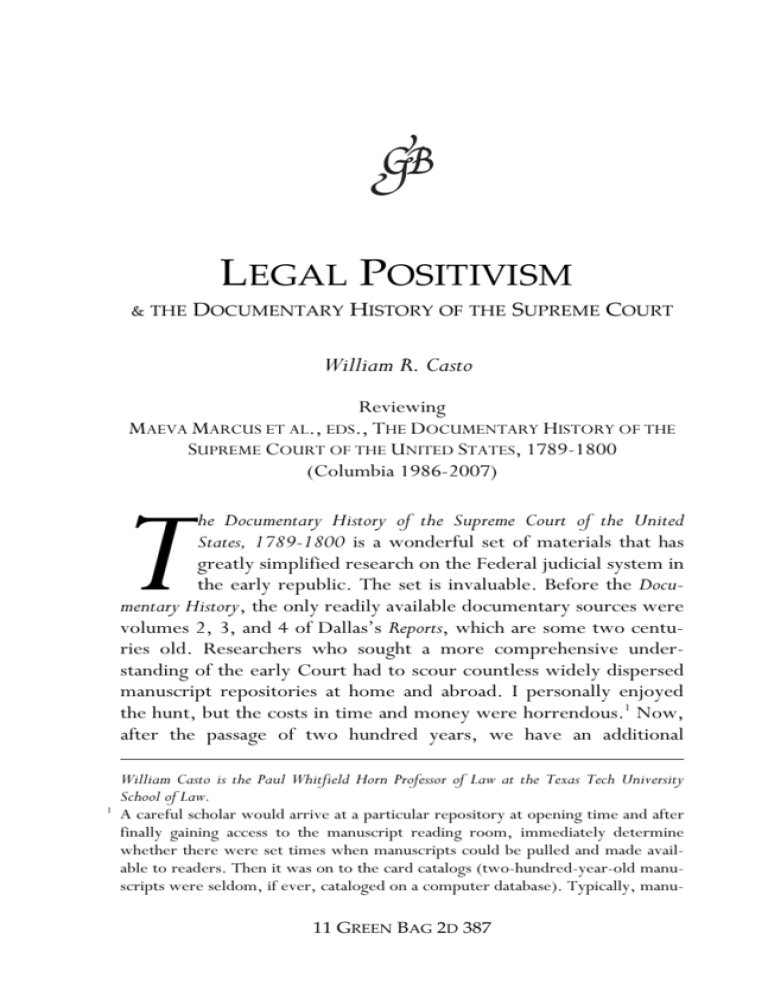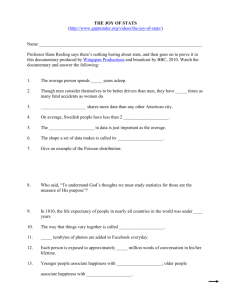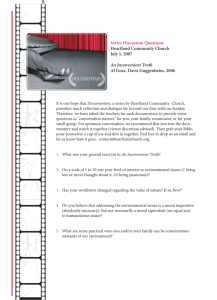Legal Positivism & the Documentary History of the
advertisement

LEGAL POSITIVISM & THE DOCUMENTARY HISTORY OF THE SUPREME COURT William R. Casto∗ Reviewing MAEVA MARCUS ET AL., EDS., THE DOCUMENTARY HISTORY OF THE SUPREME COURT OF THE UNITED STATES, 1789-1800 (Columbia 1986-2007) T he Documentary History of the Supreme Court of the United States, 1789-1800 is a wonderful set of materials that has greatly simplified research on the Federal judicial system in the early republic. The set is invaluable. Before the Documentary History, the only readily available documentary sources were volumes 2, 3, and 4 of Dallas’s Reports, which are some two centuries old. Researchers who sought a more comprehensive understanding of the early Court had to scour countless widely dispersed manuscript repositories at home and abroad. I personally enjoyed the hunt, but the costs in time and money were horrendous.1 Now, after the passage of two hundred years, we have an additional ∗ 1 William Casto is the Paul Whitfield Horn Professor of Law at the Texas Tech University School of Law. A careful scholar would arrive at a particular repository at opening time and after finally gaining access to the manuscript reading room, immediately determine whether there were set times when manuscripts could be pulled and made available to readers. Then it was on to the card catalogs (two-hundred-year-old manuscripts were seldom, if ever, cataloged on a computer database). Typically, manu11 GREEN BAG 2D 387 William R. Casto source. A researcher simply calls the library and asks for the Documentary History’s eight volumes2 to be delivered. When the set arrives, almost everything that one would wish to know about the early Supreme Court is ready to hand. Volume 1 covers the appointment process for the various justices, and volumes 2 and 3 cover the justices’ circuit riding. Questions about the judiciary’s statutory framework are covered in volume 4, which treats every pertinent statute enacted by the first six Congresses. Volumes 5 through 8 present a comprehensive treatment of each individual case that the Court considered through 1800. One of the set’s hidden treasures is the wonderfully detailed index to each volume. A minor boon that should not be overlooked is the luxury of not having to decipher the handwritten scrawl of important players in the creation and operation of the early federal courts. To be sure, the handwriting of some members of the Founding Generation is easily scanned. Oliver Ellsworth’s is a delight. He wrote in large, precise, and rounded letters. Others, like William Paterson, are more difficult, but once you get the hang of thorns3 and long s’s,4 there is no serious problem. Then there is the nightmare of James Iredell. At first glance, his writing is deceptively precise, but the formation of his letters is subtly idiosyncratic. Moreover, spaces that ordinarily mark the ending or beginning of words frequently signify nothing more than the fact that he has paused to re-dip his pen in ink. The result is that portions of words are routinely conjoined with portions of other words, and the spaces between groups of let- 2 3 4 scripts were organized by sender and sendee, so the reader would have a list of thirty or forty usual suspects to seek. Then the reader would turn to microfilmed newspapers from the era. It was all one big happy, albeit quite inefficient, Easter egg hunt. Actually, volume 1 is broken into two separate books. So there really are nine volumes. The obsolete eighteenth century letter that to modern eyes looks like a “y” but actually signifies the conjoining of the letters t and h. No one in the Founding Generation ever said “ye.” They wrote a two-character word that looks like “ye” and pronounced it “the.” The double s that novice readers misread as “ff.” 388 11 GREEN BAG 2D Legal Positivism & the Documentary History ters may signify neither the beginning nor the ending of a word. What a joy it now is to read Iredell’s thoughtful writings in clear print. The Documentary History’s value cannot be overestimated, but it – like all valuable documentary histories – cannot be treated as a complete record of its subject. Invaluable as the Documentary History is, it nevertheless has significant limitations. The project was conceived by and principally supervised by lawyers. To be sure, the editors of the project are capable – even gifted – historians, but the entire project is subtly and significantly influenced by a pragmatic form of legal positivism that holds sway among contemporary lawyers. There may be significant theoretical objections to legal positivism, but it is an empirical fact that American lawyers are predominantly positivists. At least American lawyers believe that the judicial process involves a highly specialized form of lawmaking. To a significant degree, judges do not simply administer pre-existing laws – they also make laws. They exercise legislative authority, and the laws that they frame are promulgated in the form of judicial opinions. We place great stress on studying the actions of courts and especially on judges’ opinions because we want to understand the legal rules that judges are legislating. The idea that judges make laws originated in innovative analyses of the common law,5 but this expanded vision of legislative jurisdiction is also pertinent to statutory and constitutional interpretation. If the words of a written rule are subject to plausible but different interpretations, a judge must select one of the interpretations. Unlike the legislative and executive branches, the judicial branch’s power to refuse to decide is quite limited. Once the judge has selected a proper interpretation, the law of precedent requires that the judge’s opinion be followed in future cases. The judge has, in effect, supplemented the words of the statute or constitution. This 5 See William R. Casto, The Erie Doctrine and the Structure of Constitutional Revolutions, 62 TULANE L. REV. 907, 921-22 (1987) (discussing John Austin and Jeremy Bentham). SPRING 2008 389 William R. Casto vision of judicial lawmaking is a fundamental paradigm that informs all practicing lawyers’ analyses and understandings of modern law. Within any particular jurisdiction, trial judges and appellate judges are more or less equal in their ability to frame laws and to determine appropriate interpretations of ambiguous rules, but like in Animal Farm, the appellate judges are arbitrarily deemed to be more equal than the trial judges. The concept of appellate review technically gives appellate judges raw power to overturn lower court interpretations. An appellate judge’s opinion is only coincidentally superior in substance to the lower court judge’s opinion, but as a matter of raw power, appellate judges’ opinions prevail.6 In the early twenty-first century, lawyers under the sway of legal positivism have properly elevated United States Supreme Court opinions to the pinnacle of judicial authority. No power outside the Supreme Court trumps the Court’s determination of an issue of constitutional law.7 We have a deep thirst to understand the Supreme Court’s actions because the Court’s opinions are arbitrarily deemed to be the ultimate word on the meaning of the Constitution. The Court’s pronouncements are not necessarily wise, but the justices have the final word. As Justice Robert Jackson famously quipped, the Court is “not final because we are infallible, but we are infallible only because we are final.”8 Today’s apotheosis of the Supreme Court would have puzzled attorneys and judges of the late eighteenth century. To them, the 6 7 8 To be sure, appellate judges may correct a simple oversight or outright abuse by a trial judge. In one important letter defending judicial review, which the Documentary History does not reproduce, James Iredell affirmed the value of appellate review: “men are commonly careful enough to correct the errors of others, though seldom sufficiently watchful of their own, especially if they have no check upon them.” See William R. Casto, James Iredell and the American Origins of Judicial Review, 27 CONN. L. REV. 329, 336 (1995) (quoting letter). In addition, there sometimes is safety in numbers. Perhaps the collective judgment of three or more appellate judges is superior to one trial judge. But what do we make of a 2-1 appellate decision reversing a trial judge? Rare episodes like the eleventh and sixteenth amendments to the Constitution are the exceptions that prove the rule. Brown v. Allen, 344 U.S. 443, 540 (1953) (Jackson, J., concurring). 390 11 GREEN BAG 2D Legal Positivism & the Documentary History Court performed an important function, but few of them saw appointments to the Court as a capstone to their public careers. Of the three chief justices covered by the Documentary History, two resigned their position in favor of state political office,9 and the third (who had a recess appointment) failed his Senate confirmation vote as a result of a political disagreement.10 In the Founding Era, appointment to the Supreme Court was not nearly as coveted as it is today. This comparative lack of prestige was due in part to the fact that no one believed that the justices of that court or any other court exercised legislative authority to make laws. Americans of the Founding Era were natural lawyers – not legal positivists.11 As a matter of faith, today’s lawyers use legal positivism as a postulate for analyzing the law, and this axiom pervades virtually all contemporary legal analyses. Contemporary lawyers are properly obsessed with the Supreme Court’s opinions because the Court is the final arbiter of most federal law and nearly all constitutional law. Needless to say, lawyers concentrate on what the law is today or what it might be in the near future. Supreme Court decisions from 50 years ago are old and therefore out of date. Decisions from a hundred years ago are ancient and almost presumptively irrelevant. The Documentary History’s comprehensive study of the Court and its decisions in the 1790s has scant value for contemporary lawyers because its grist is over two centuries old. Today citations to decisions from the Court’s first decade serve as little more than quaint window-dressing.12 To be sure, many – indeed most – contempo9 Chief Justice John Jay resigned to serve as governor of New York. See WILLIAM R. CASTO, THE SUPREME COURT IN THE EARLY REPUBLIC 90 (1995). In 1796, Oliver Ellsworth assumed the chief-justiceship only to resign 4 years later. Ellsworth returned to Connecticut and served ably in the Connecticut legislature. 10 For Chief Justice John Rutledge’s brief and unfortunate career, see Casto, Supreme Court, supra note 9 at 90-95. 11 See Casto, Erie Doctrine, supra note 5. 12 In the last twenty years, the Court has cited its 1790s opinions only 50 times and 40 of the citations were to three of the early cases: Hayburn’s Case, 2 U.S. (2 Dall.) 408 (1792) (13 citations); Chisholm v. Georgia, 2 U.S. (2 Dall.) 419 (1793) (12 citations), and Calder v. Bull, 3 U.S. (3 Dall.) 386 (1798) (15 citations). SPRING 2008 391 William R. Casto rary lawyers view one aspect of late-eighteenth-century legal history as pertinent to the law as it is today. In construing the Constitution or acts of Congress, we would like to know what the framers of these laws originally thought they were accomplishing. As a practical matter, however, the Documentary History provides only sporadic evidence of our founders’ original intent.13 THE FOOTPRINTS OF LEGAL POSITIVISM UPON THE DOCUMENTARY HISTORY A lthough today’s lawyers are properly enthralled to positivism, this particular jurisprudential view of the law has no value to anyone else interested in eighteenth-century legal matters. Positivism is at best a potentially confusing anachronism and at worst a mischievous irritant. The pervasive influence of legal positivism upon the Documentary History significantly limits the set’s value to most researchers. Make no mistake, however, it clearly is the single most valuable tool for exploring the federal courts’ activities in the Founding Era, and its editors have done a magnificent job. There was a time when much legal history consisted of antiquarian analyses of the development of particular legal rules. Today, however, most legal historians are concerned with the relationship between law and society. The creation and operation of legal systems is viewed as an important aspect of society as a whole. We have little interest in the historical development of any particular legal doctrine, except insofar as the development may form a concrete background or context for illustrating or understanding law and society. Because the Documentary History concentrates almost entirely upon cases that reached the Supreme Court, there are a number of significant lacunæ that must be filled from other sources. With a few praiseworthy exceptions, the justices’ thoughts and actions are only covered insofar as they wrote or acted as Supreme Court justices. When the justices addressed immensely important issues in a 13 Volume 5 is devoted entirely to suits against states and includes valuable background information on the eleventh amendment. 392 11 GREEN BAG 2D Legal Positivism & the Documentary History non-judicial capacity, the Documentary History’s coverage is nonexistent or at best sporadic. Similarly, the justices’ opinions rendered in the circuit courts are largely ignored unless a particular case was coincidentally appealed. Viewed through the lens of legal positivism, the Documentary History’s sharp distinction between the justices’ Supreme Court opinions and their lower court and extrajudicial opinions makes perfect sense. When a justice decides a case in the Supreme Court, the justice exercises the nation’s highest lawmaking authority.14 Conversely, when a justice utters the same thoughts outside the Supreme Court decision-making process, the thoughts may be dismissed as mere private opinion rather than an official and binding pronouncement of the law. The pervasive influence of legal positivism and the Documentary History’s consequent shortcomings are illustrated by episodes in the careers of Chief Justice John Jay, Chief Justice Oliver Ellsworth, and Justice Iredell. I The Justices on Circuit n the 1790s, the justices performed two equally important functions. They collectively served as the federal government’s highest appellate court, and they individually rode circuit and served as trial judges in the circuit courts distributed throughout the nation.15 In their capacity as trial judges, they rendered numerous opinions – most of which the Documentary History ignores. The problem is that these valuable opinions are technically lower court opinions and therefore not within the Documentary History’s scope. The shortcomings of concentrating almost exclusively on the Supreme Court’s docket are illustrated by the Documentary History’s treatment of three lower court decisions: Cowper v. Telfair,16 Minge v. Gilmour,17 and 14 Of course, when the Court renders an opinion on subconstitutional federal law (typically an act of Congress), the decision is subject to legislative revision. In practice, however, Congress seldom overturns the Court’s interpretations. 15 See Casto, Supreme Court, supra note 9 at 45. 16 Cowper v. Telfair, 8 DOCUMENTARY HISTORY at 353 (C.C. Ga. 1799), aff’d sub nom. Cowper v. Telfair, 4 U.S. (4 Dall.) 14 (1800). 17 Minge v. Gilmour, 17 F. Cas. 440 (C.C.D.N.C. 1798) (No. 9631). SPRING 2008 393 William R. Casto United States v. Ravara.18 In each case, Supreme Court justices, riding circuit, rendered valuable opinions regarding judicial review and the nature of constitutional interpretation. But only one of the cases is fully documented for the simple – even arbitrary – reason that only one of the cases coincidentally was appealed to the Supreme Court. Chief Justice Ellsworth’s circuit court opinion in Cowper is particularly interesting because it is the only judicial opinion from an early Supreme Court justice that clearly uses framers’ intent as at least a partial basis for constitutional interpretation.19 We now have it conveniently available only because the case was fortuitously appealed to the Supreme Court. In contrast, the Minge case, in which Justice Iredell provided his fully elaborated thoughts on the Constitution’s ex post facto clause and the desirability of using natural law as a basis for judicial review, was not appealed. Therefore, we do not have a full elaboration of the context of Iredell’s opinion. In fairness, it should be noted that the Documentary History provides a brief notice of Minge in its treatment of Calder v. Bull,20 an unrelated case that happened to be appealed to the Court. In Calder v. Bull, Justice Samuel Chase famously appeared to suggest that a court might resort to supraconstitutional, natural-law principles as a basis for declaring a state law to be void.21 In re18 United States v. Ravara, 2 U.S. (2 Dall.) 297 (C.C.D. Pa. 1793). See Casto, Iredell, supra note 6 at 360-62. The justices also invoked framers’ intent when they declined to provide President Washington with an advisory opinion, see Casto, Supreme Court, supra note 9 at 80 & 233. See generally WILLIAM R. CASTO, FOREIGN AFFAIRS AND THE CONSTITUTION IN THE AGE OF FIGHTING SAIL ch. 7 (2006). Because the letter was signed by all but one justice (who was absent), the letter comes close to being the considered opinion of the Court. Happily, the Documentary History provides us with much of the pertinent record in an appendix. 6 DOCUMENTARY HISTORY at 743-58. 20 Calder v. Bull, 3 U.S. (3 Dall.) 386 (1798). See 8 DOCUMENTARY HISTORY at 93, 97 & 98-99. The Documentary History provides a somewhat better treatment of Vanhorne’s Lessee v. Dorrance, 2 U.S. (2 Dall.) 304 (C.C.D. Pa. 1795), in which Justice William Paterson explained his views on judicial review. 8 DOCUMENTARY HISTORY at 161-63, 477-98. The editors note that the case was appealed to the Supreme Court but never argued or adjudicated. Id. 21 Calder v. Bull, 3 U.S. (3 Dall.) at 388-89. 19 394 11 GREEN BAG 2D Legal Positivism & the Documentary History sponse, Justice Iredell firmly rejected this suggestion because “ideas of natural justice are regulated by no fixed standard: the ablest and the purest men have differed upon the subject.”22 The Documentary History notes that this exchange has become “the focus of an ongoing debate about legitimate methods of interpreting the Constitution.”23 Iredell’s more carefully considered opinion on precisely this same issue in Minge is relegated to a brief footnote.24 As a matter of legal history, the Documentary History’s treatment of Iredell’s opinions in Minge and Calder is precisely backward. Minge is clearly the more important opinion, and Calder should be relegated to a “see also” footnote. Iredell himself undoubtedly preferred his Minge opinion. He expressly stated that his circuit court opinion was informed by the oral argument in Calder,25 and his lower court opinion was significantly more detailed and nuanced than his Calder opinion.26 Finally, Iredell stated in Calder that he was speaking extemporaneously because “I have not had an opportunity to reduce my opinion to writing.”27 The treatment of Iredell’s opinions in Minge and Calder starkly illustrates the perverse influence of legal positivism’s hidden hand. The opinions were given two months apart and were significantly based on the same oral argument. One is more detailed and nuanced than the other, and Iredell confessed that he delivered his lessdetailed opinion off the top of his head. Indeed, his Supreme Court opinion is essentially an incomplete summary of the more detailed opinion that he had delivered just two months earlier. The only 22 Id. at 399. 8 DOCUMENTARY HISTORY at 89; see also id. at 99. 24 Id. at 97 n.52. 25 Minge v. Gilmour, 17 F. Cas. 440, 443 (C.C.D.N.C. 1798) (No. 9631). 26 In addition to addressing the serious epistemological problem of discerning the precise content of natural-law principles, Iredell presented a good textual argument for rejecting natural law as a basis for judicial review. Minge, 17 F. Cas. at 444. He also explained that natural law could reenter a case as a principle of statutory construction. Id. Absent clear legislative language, a judge should presume that the legislature did not intend to violate natural law principles. 27 Calder v. Bull, 3 U.S. (3 Dall.) at 398. 23 SPRING 2008 395 William R. Casto conceivable reason for preferring the summary opinion over the fully-developed one is that the former was coincidentally uttered to decide an appeal in the Supreme Court. In today’s culture of legal positivism, the arbitrary preferment of the partial summary makes sense in the context of arguing what the law of judicial review should be in the twenty-first century. In contrast, a legal historian seeking to understand law and society in the early eighteenth century surely should prefer the comprehensive lower court opinion to its pallid Supreme Court summary. At least Iredell’s opinion in Minge is readily available in West’s Federal Cases. The same cannot be said of his opinion in United States v. Ravara.28 The case was a criminal prosecution of a Genoan consul, and the consul argued that under the Constitution, such prosecutions had to be tried before the Supreme Court and could not be tried in a lower federal court. The case is not covered in the Documentary History29 because it was not appealed. The failure to document Ravara is particularly significant because it is one of the best early cases – I think the best – for understanding the early justices’ thinking on the relationship between constitutional interpretation and judicial review.30 Moreover, Dallas’s report of the case is utterly inadequate. He drastically compressed Iredell’s opinion into a two-sentence summary.31 Iredell’s own statement of his opinion is much more detailed and nuanced, but remains nearly inaccessible.32 The lack of an appeal in Ravara was not a coincidence of litigation. There was no appeal because the early Supreme Court lacked 28 United States v. Ravara, 2 U.S. (2 Dall.) 297 (C.C.D. Pa. 1793). For an able and valuable discussion of the case, see John Gordan, United States v. Ravara: “Presumptuous Evidence,” “Too Many Lawyers,” and a Federal Common Law, in ORIGINS OF THE FEDERAL JUDICIARY 106-72 (M. Marcus ed. 1992). 29 The case is briefly noted in respect of an issue irrelevant to the case’s important constitutional issue. 8 DOCUMENTARY HISTORY at 76 n.14. 30 For the detailed analysis, see Casto, Iredell, supra note 6. 31 2 U.S. (2 Dall.) 297 (C.C.D. Pa. 1793). 32 See Casto, Iredell, supra note 6 at 342-45. 396 11 GREEN BAG 2D Legal Positivism & the Documentary History appellate jurisdiction over federal criminal cases.33 The result is that, with the exception of grand jury charges, the Documentary History practically ignores federal criminal prosecutions in the 1790s. It devotes two volumes to the justices’ circuit-riding duties, but the emphasis is on circuit-riding itself, rather than adjudication. We learn how the justices felt as they toured the nation, but we do not learn much about the cases that they tried. The Documentary History’s most valuable contribution regarding the justices’ circuit-riding activities is the reproduction of their grand jury charges. These were not simple instructions detailing the content of federal law. Instead, the justices, following existing tradition, used their charges to address a broad range of political and legal issues confronting the nation.34 These political essays provide invaluable insight into the justices’ minds and now are readily available. D Extrajudicial Political Activities uring Chief Justice Jay’s tenure, the most important issue confronting the nation was the extent to which revolutionary France should be supported in its war with Great Britain. The proper extent of American neutrality utterly dominated national political life in 1793, and all the branches of government had to grapple with this explosive issue.35 In particular, the federal courts were called to service in a series of high-profile civil actions and criminal prosecutions that the Documentary History leaves largely unexamined because the lower court decisions were not appealed.36 33 See JULIUS GOEBEL, HISTORY OF THE SUPREME COURT OF THE UNITED STATES: ANTECEDENTS AND BEGINNINGS TO 1801, 609-11 (1971). 34 See Casto, Supreme Court, supra note 9 at 126-29. 35 See Casto, Foreign Affairs, supra note 19. 36 See id. ch. 6. The Documentary History provides a thumbnail sketch of Henfield’s Case, 11 F. Cas. 1099 (C.C.D. Pa. 1793) (No. 6360). The most important civil action was Findlay v. The William, 9 F. Cas. 57 (D. Pa. 1793) (No. 4790), in which the district court held that a United States court lacked jurisdiction to consider the legality of a capture by a French privateer. Most of the other district courts that considered the issue agreed. See Casto, Foreign Affairs, supra note 19 at 86-90. The Documentary History makes only passing reference to a few of these controverSPRING 2008 397 William R. Casto Nor does the Documentary History detail much of Chief Justice Jay’s extrajudicial machinations to support a pro-British foreign policy. In the beginning, Jay worked behind the scenes. He provided an advisory opinion to Secretary of the Treasury Alexander Hamilton on legal issues related to neutrality and even drafted a neutrality proclamation for Hamilton’s consideration.37 Later, after Edmond Charles Genet, the French ambassador, became a thorn in the Executive Branch’s side, Jay lent his name to a public newspaper attack on Genet.38 Because neither Jay’s initial advisory opinion nor his public assault on the French ambassador related directly to litigation before the Court, Jay’s actions do not help us to understand or interpret a Supreme Court decision. Therefore, these two episodes do not fit the Documentary History’s positivist plan, and they are not even mentioned. Ambassador Genet consulted attorneys and planned to bring an action for criminal libel against Jay in the Supreme Court, but he never commenced the prosecution.39 So the Documentary History is likewise silent on this fascinating scheme. Iredell’s Understandings of Judicial Review and Church and State F inally, the Documentary History virtually ignores Justice Iredell’s understanding of the proper constitutional relationship between church and state. At the North Carolina ratification convention in 1788, he presented a vigorous, comprehensive, and sophisticated defense of the framers’ decision not to require a religious test for holding federal office.40 Whether a government could impose a state religion upon its citizens was an immensely important question in the late eighteenth century, and the question’s importance continsial cases in a case involving the same issue a year later. See 6 DOCUMENTARY HISTORY at 299 n.10. 37 See Casto, Foreign Affairs, supra note 19 at 27-28. Id. at 139-43, 146-50. 39 See id. at 150; see also William Casto, America’s First Independent Counsel: The Planned Criminal Prosecution of Chief Justice John Jay, 1 GREEN BAG 2D 353 (1998). 40 4 THE DEBATES IN THE SEVERAL STATE CONVENTIONS, ON THE ADOPTION OF THE FEDERAL CONSTITUTION 192-96, 196-98 (Jonathan Elliot 2d ed. 1891). 38 398 11 GREEN BAG 2D Legal Positivism & the Documentary History ues to the present. Because Iredell coincidentally presented his detailed thoughts outside of proceedings in the Supreme Court, his careful analysis is beyond the Documentary History’s purview. In contrast, it discusses, by chance, one of Iredell’s public essays in support of ratifying the Constitution because the essay addressed an issue that, by coincidence, later came before the Court.41 Another of the Documentary History’s lacunæ is its almost total silence regarding Iredell’s thoughts on the controversial doctrine of judicial review.42 Simply stated: No founder, including John Marshall, penned an explanation and justification of the doctrine that is as detailed, sophisticated, and nuanced as Iredell’s.43 His thoughts, however, appear in public and private letters related to a case that was litigated in North Carolina state court before the United States Supreme Court was created. A CONCLUDING THOUGHTS ll research related to the federal judiciary in the early republic must now begin with the Documentary History. But this wonderful history must be supplemented by other sources. There are magnificent ongoing documentary projects for the ratification of the Constitution44 and the first Congress.45 There are also old workhorses like the American State Papers46 and the Annals of Congress.47 41 8 DOCUMENTARY HISTORY at 98 n.8, discussing James Iredell, Marcus I, reprinted in 16 DOCUMENTARY HISTORY OF THE RATIFICATION OF THE CONSTITUTION 161-69 (J. Kaminski & G. Saladino eds. 1986). 42 The Documentary History cites a private letter in which he defended judicial review, but does not mention a valuable newspaper article that he published on the subject. 1 DOCUMENTARY HISTORY at 62. 43 See Casto, Iredell, supra note 6. 44 DOCUMENTARY HISTORY OF THE RATIFICATION OF THE CONSTITUTION (1976present) (19 volumes to date). 45 DOCUMENTARY HISTORY OF THE FIRST FEDERAL CONGRESS OF THE UNITED STATES (1972-present) (14 volumes to date). 46 AMERICAN STATE PAPERS: DOCUMENTS, LEGISLATIVE AND EXECUTIVE OF THE CONGRESS OF THE UNITED STATES (1832-1861) (38 volumes). 47 ANNALS OF THE CONGRESS OF THE UNITED STATES (1834-56) (42 volumes). SPRING 2008 399 William R. Casto There are also the excellent papers of Alexander Hamilton, James Madison, Thomas Jefferson, and George Washington. Regrettably, there are no adequate collections of the papers of Chief Justices Jay48 and Ellsworth. Then of course, there remains the old Easter egg hunt.49 Notwithstanding the bulk of this essay, I have come to praise the Documentary History – not to bury it. To repeat: the Documentary History clearly is the single most valuable tool for exploring the federal courts’ activities in the Founding Era, and its editors have done a magnificent job. When legal history is defined broadly as the relationship among law, legal institutions, and society, the relevance of extant documents is virtually limitless. Therefore, in any documentary history project, lines have to be drawn, and the resulting limitations will inevitably yield quite arbitrary distinctions at the margins. For example, if the scope of the Documentary History were expanded to encompass the cases adjudicated by the justices in the circuit courts, the extremely important admiralty litigation in the district courts would still be excluded. Moreover, as a practical matter, very real constraints of time and money would preclude an expansion to circuit court cases. 48 The modern documentary project on the Jay papers was regrettably suspended before reaching the era of the federal government. 49 See note 1, supra. 400 11 GREEN BAG 2D








